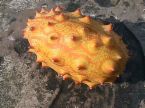 return
return
Kiwano melon a fruit with hornshttp://www.foodreference.com/html/art-kiwano-melon.html
Kiwano melon is an oval shaped fruit with horns on its peel. It has a bright orange and yellow skin with a pale yellow-green pulp inside. The flavor of the pulp is sweet and a bit tart with a flavor mix of bananas, lime and cucumber. Kiwano melon is native to southern and central Africa and is commonly known as an African horned melon.
Most imported melons are now from New Zealand. California has began growing this melon, so a domestic product is available part of the year.
Selection Select melons without any bruises or spots with a bright orange color. It is best to purchase a melon that has the horns intact, as damaged horns may be a sign of rough handling.
Kiwano melons are available year round in specialty markets and supermarkets. Storage Unripe melons may be stored at room temperature for up to two weeks. Ripe melons will last about 3 to 4 days at room temperature. There is no need to refrigerate kiwano melon.
Nutrition Value % Daily Value Serving Size 1 melon (100g) Amount per Serving: Calories 25 Amount per Serving:
The horned cucumber plant is a vine 5-10 feet long of African origin. The stem is angular, ridged and hairy; internodes are 2-3 inches long. At each node, a 1-2 inch long curling tendril forms, along with two to four pale yellow male flowers, a leaf petiole, and occasionally a fruiting branch. The small, deeply cut, five-lobed leaves are similar to those of the watermelon. The fruits have an oblong shape, are 2 to 4 inches long, light-green until maturity and have distinctive, long, sharp spines on their exterior.
Harvest and postharvest handling. USDA storage recommendations are 50� to 60�F (10� to 15�C) at 90 percent relative humidity, with an approximate storage life of 6 months. Do not stack the fruit as the spines can puncture other fruit. In New Zealand spines are made blunt by sanding.
The spiny fruits have a bland citrus or banana-like flavor. They are difficult to use because of the seeds. The fruit pulp can be strained to make a juice.
The fruit turns bright orange when it is ripe. The ripe interior has a lime green jelly-like flesh with large seeds. The primary marketing thrust, however, is to sell the fruit for garnishes or decorative purposes.